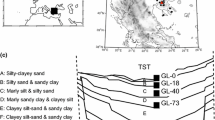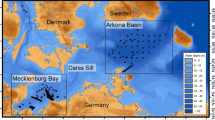Abstract
Knowledge of physical properties of near-surface sediments is an important requirement for many studies of the seafloor. Dynamic or Free Fall Penetrometers (FFP), instrumented with accelerometers, are widely used to assess the mechanical properties of the sediment by deriving penetration resistance from the deceleration response of the probe as it impacts and embeds the seabed. Other field investigations, a priori knowledge or a very basic description of the type of sediment (such as a description of the sediment as soft, medium or hard) derived from studying the deceleration response (accelerometer-time histories) are used for sediment identification prior to the application of an appropriate strength determination model. In many cases this information is site-specific and in others the penetration resistance is overestimated due to the dilatory effects observed in sediment with an undetected grain fraction. In this study variables affecting a dynamic penetrometer-sediment interaction system are identified. Using data from field investigations and literature we found a relationship among five variables: peak acceleration, embedment depth, total embedment time, velocity of impact and grain size. This is used to formulate a sediment identification model. The model accounts for variables that may vary widely within one deployment and it can be applied to other FFPs with different physical characteristics (such as a different mass or size). This may lead to the increased use of FFP as a deployment tool for rapid in situ characterization of the seafloor.















Similar content being viewed by others
Notes
The terms Penetrometer, free fall probe, impact probe or dynamic penetrometer have been used in previous studies to refer to the same device. In this study this device will be referred to interchangeably as a free fall probe, penetrometer or probe.
“Acceleration-time histories” is a term coined by researchers studying planetary bodies to describe the response of probes impacting the surfaces of planets even though it is strictly a time series of deceleration response of the probe as it impacts the surface (see, e.g., McCarty and Carden 1962).
References
Aubeny CP, Shi H (2006) Interpretation of impact penetration measurements in soft clays. J Geotech Geoenviron Eng 132:770–777. doi:10.1061/(ASCE)1090-0241(2006)132:6(770)
Awoshika K, Cox WR (1968) An application of similitude to model design of a soil-projectile system. National Aeronautics and Space Administration (NASA) technical report (NASA CR-1210). University of Texas at Austin
Ball AJ (1997) Measuring physical properties at the surface of a comet nucleus. Dissertation, University of Kent, UK
Blackwood D, Parolski K (2001) Seabed observation and sampling system. Sea Technol 43:39–40
Blott SJ, Pye K (2001) GRADISTAT: a grain size distribution and statistics package for the analysis of unconsolidated sediments. Earth Surf Process Landf 26:1237–1248. doi:0.1002/esp.261
McCarty JL, Carden HD (1968) Response characteristics of impacting penetrometers appropriate to lunar and planetary missions. National Aeronautics and Space Administration (NASA) technical report (NASA-TN-D-4454). University of Texas at Austin
Dayal U, Allen JW (1973) Instrumented impact cone penetrometer. Can Geotech J 10:397–409. doi:10.1139/t73-034
Elsworth D, Lee DS, Hryciw R, Shin S (2006) Pore pressure response following undrained uCPT sounding in a dilating soil. J Geotech Geoenviron 132:1485–1495. doi:10.1061/(ASCE)1090-0241(2006)132:11(1485)
Fasanella EL, Jones Y, Knight NF, Kellas S (2001) Low velocity earth-penetration test and analysis. In: 42nd AIAA/ASME/ASCE/AHS/ASC structures, structural dynamics, and materials conference and exhibit Seattle, WA, Apr. 16–19, Proceedings of no. AIAA-2001-1388
Folk R, Ward W (1957) Brazos river bar: a study in the significance of grain size parameters. J Sediment Petrol 27:3–27
Garry J, Towner M, Ball A, Zarnecki J, Marcou G (1999) The effect of ambient pressure and impactor geometry on low speed penetration of unconsolidated materials. Adv Space Res 23:1229–1234. doi:10.1016/S0273-1177(99)00189-1
Glaser DL, Ball AJ, Zacny KA (2008) A review of penetrometers for subsurface access on comets and asteroids. Meteorit Planet Sci 43:1021–1032. doi:10.1111/j.1945-5100.2008.tb00690.x
Goodnight DJ (2003) Impact of a large sphere into a bed of cohesionless particles. Dissertation, Department of Marine, Earth and Atmospheric Sciences, North Carolina State University
Hansen NEO, Gislason K (2007) Soil reactions in saturated sand caused by impulsive loads. J Waterw Port Coast Ocean Eng 133:39–49. doi:10.1061/(ASCE)0733-950X(2007)133:1(39)
Hill S (2006) Grain size analysis of sediment samples from Bering Sea research cruise. Technical report, GeoSea Consulting Ltd., Brentwood Bay, BC, Canada. Alaska Fisheries Science Center, NOAA, Seattle, WA
Kömle NI, Kargl G, Ball AJ (2001) Determination of physical properties of planetary sub-surface layers by artificial impacts and penetrometry. Adv Space Res 28:1539–1549. doi:10.1016/S0273-1177(01)00363-5
Lunne T, Robertson PK, Powell JJM (1997) Cone penetration testing in geotechnical practice. Spon Press
Meunier J, Sangouard D, Lhuillier B (2000) A new seabed penetrometer. In: Offshore technology conference, Houston, Texas, Proceedings. doi:10.4043/12095-MS
Matlab (2008) Release 2008b, User Documentation. The MathWorks, Natick, Massachusetts
McCarty JL, Carden HD (1962) Impact characteristics of various materials obtained by an acceleration-time history technique applicable to evaluating remote targets. National Aeronautics and Space Administration (NASA) technical report (NASA-TN-D-1269). University of Texas at Austin
Osler J, Furlong A, Christian H (2006) A sediment probe for the rapid assessment of seabed characteristics environment. In: Cait A, Chapman N, Hermand JP, Jesus S (eds) Acoustic acoustic sensing techniques for the shallow water environment: inversion methods and experiments. Springer, Netherlands, pp 171–181
Peterson CH, Summerson HC, Lenihan TE, Grabowski HS, Manning J, Micheli L, Johnson G (2000) Synthesis of linkages between benthic and fish communities as a key to protecting essential fish habitat. Bull Mar Sci 66:759–774
Poor AR, Cox WR, Reese LC (1965) Behavior of sandy clay under vertical impact of geometric shapes. National Aeronautics and Space Administration (NASA) technical report (NASA-CR-64838). University of Texas at Austin
Smith KR, McConnaughey RA (1999) Surficial sediments of the eastern Bering Sea continental shelf: EBSSED database documentation US Department of Commerce, NOAA Technical Memo NMFS-AFSC-104
Song CR, Voyiadjis GZ (2005) Pore pressure response of saturated soils around a penetrating object. Comput Geotech 32(1):37–46. doi:10.1016/j.compgeo.2004.11.003
Spooner IS, Williams P, Martin K (2004) Construction and use of an inexpensive, lightweight free-fall penetrometer: applications to paleolimnological research. J Paleolimnol 32:305–310. doi:10.1023/B:JOPL.0000042997.78454.e2
Stark N, Wever TF (2009) Unraveling subtle details of expendable bottom penetrometer (XBP) deceleration profiles. Geo-Mar Lett 29:39–45. doi:10.1007/s00367-008-0119-1
Stark N, Hanff H, Kopf A (2009) Nimrod: a tool for rapid geotechnical characterization of surface sediments. Sea Technol 29:10–14
Stegmann S, Villinger H, Kopf A (2005) Design of a modular, marine free-fall cone penetrometer. Sea Technol 47:27–33
Stoll RD, Akal T (1999) XBP-tool for rapid assessment of seabed sediment properties. Sea Technol 40:47–51
Stoll RD, Sun YF, Bitte I (2007) Seafloor properties from penetrometer tests. IEEE J Oceanic Eng 32:57–63. doi:10.1109/JOE.2007.890943
True DG (1976) Undrained vertical penetration into ocean bottom soils. Dissertation, University of California at Berkeley
Womack DP, Cox WR (1967) Measurement of dynamic characteristics of soils with penetrometers. National Aeronautics and Space Administration (NASA) technical report (NASA-CR-849) University of Texas at Austin
Acknowledgments
This work was performed at the Jere A. Chase Ocean Engineering Laboratory, University of New Hampshire. Support was provided by a grant from Alaska Fisheries Science Center (AFSC), part of the National Oceanic and Atmospheric Administration’s (NOAA) National Marine Fisheries Service (NMFS). Special thanks to Dr. Robert McConnaughey at AFSC for coordinating the field investigation. Glenn McGillicuddy assisted Dr. Lloyd Huff with the deployment of the FFCPT. We gratefully acknowledge the comments received from three anonymous reviewers.
Author information
Authors and Affiliations
Corresponding author
Additional information
An erratum to this article can be found at http://dx.doi.org/10.1007/s11001-011-9124-2
Rights and permissions
About this article
Cite this article
Mulukutla, G.K., Huff, L.C., Melton, J.S. et al. Sediment identification using free fall penetrometer acceleration-time histories. Mar Geophys Res 32, 397–411 (2011). https://doi.org/10.1007/s11001-011-9116-2
Received:
Accepted:
Published:
Issue Date:
DOI: https://doi.org/10.1007/s11001-011-9116-2




